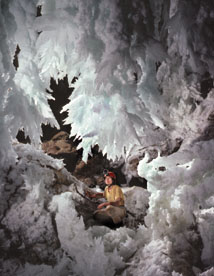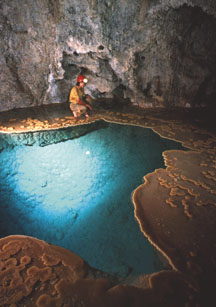Omega Cave is not alone in its secrecy. As an increasing number of people seek to explore caves, many landowners struggle to protect their properties, while cavers strive to gain access.
Access to a cave depends on the number of previous visitors, the organisms and ecosystems in the cave, the presence of endangered species, its geologic features, its beauty, its danger and the owner, says Emily Davis, a volunteer for the NSS and the Northeastern Cave Conservancy (NCC).

Margaret Palmer gazes at the large gypsum
crystals in the Chandelier Ballroom of New
Mexico's Lechuguilla Cave. Photos courtesy
of Arthur Palmer, State University of New York
at Oneonta.

